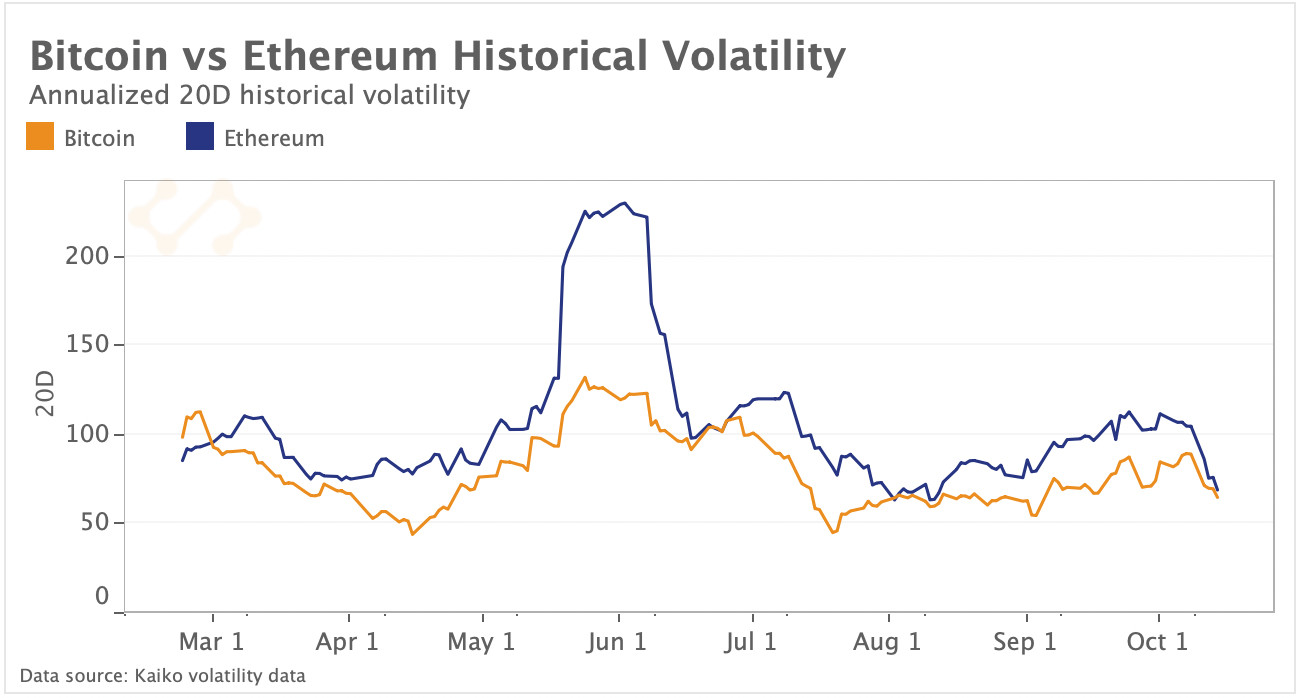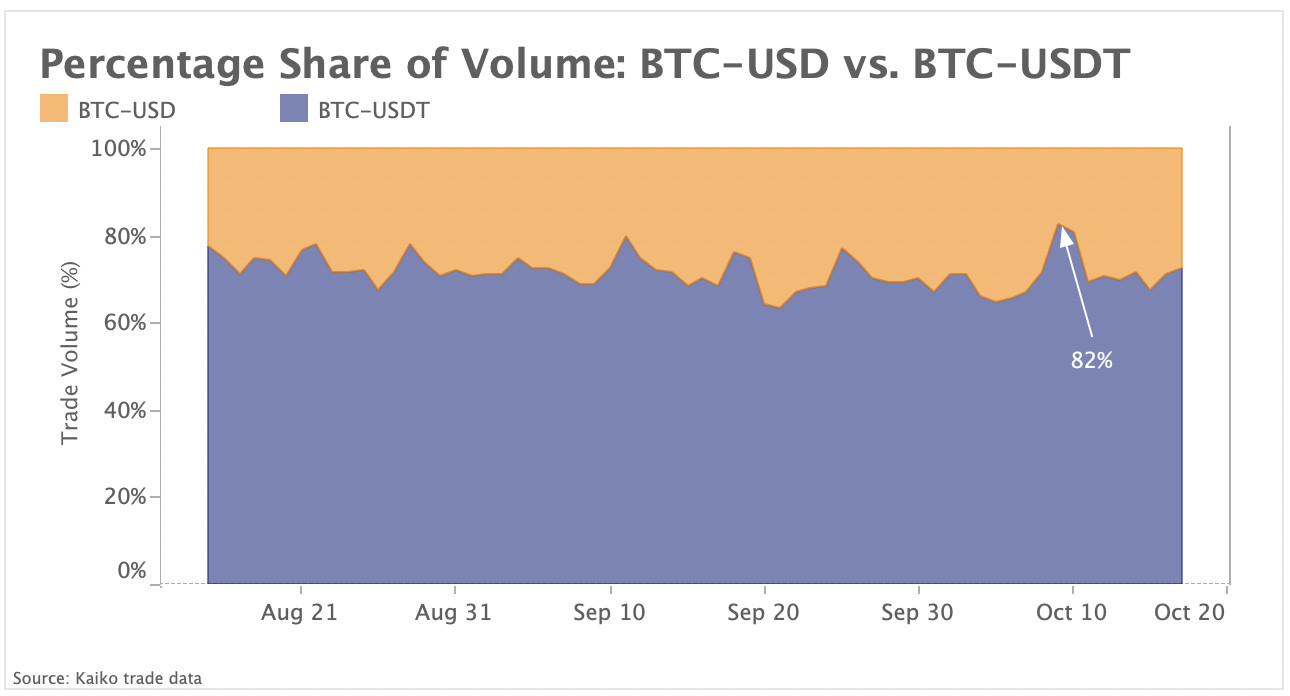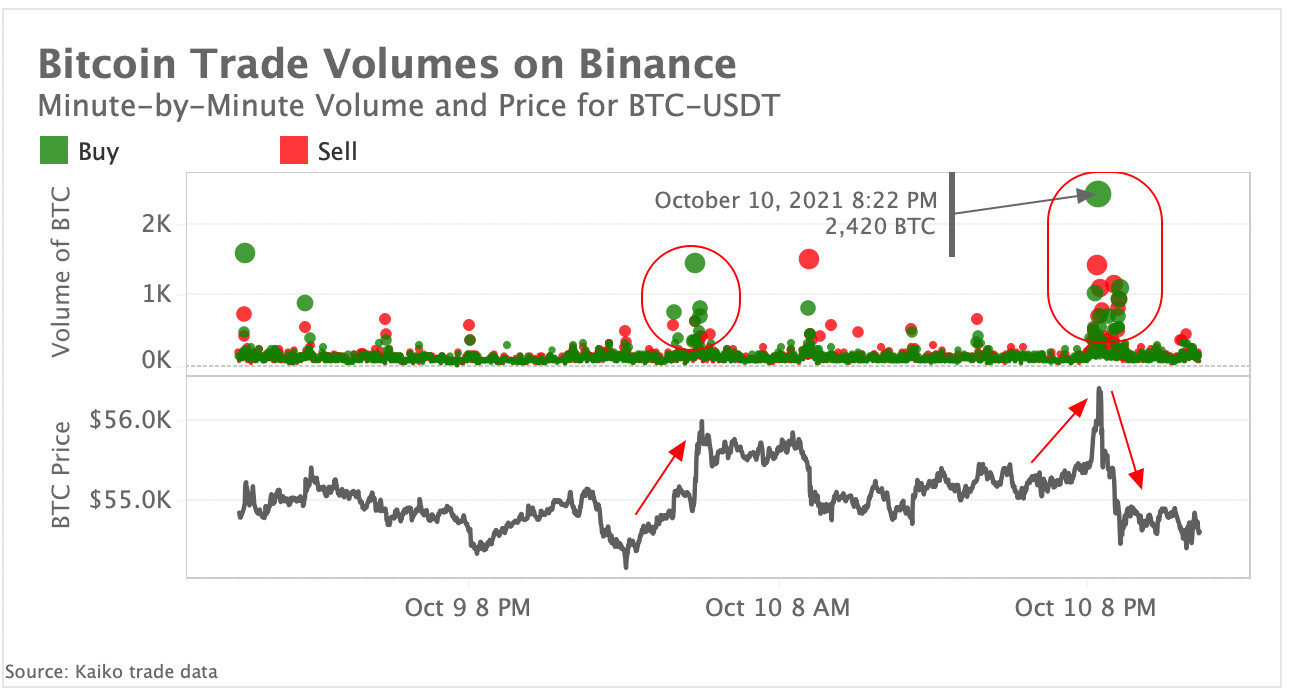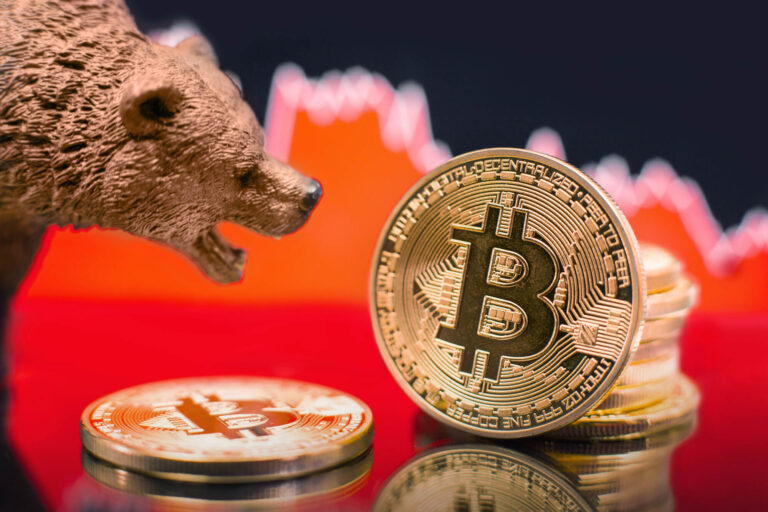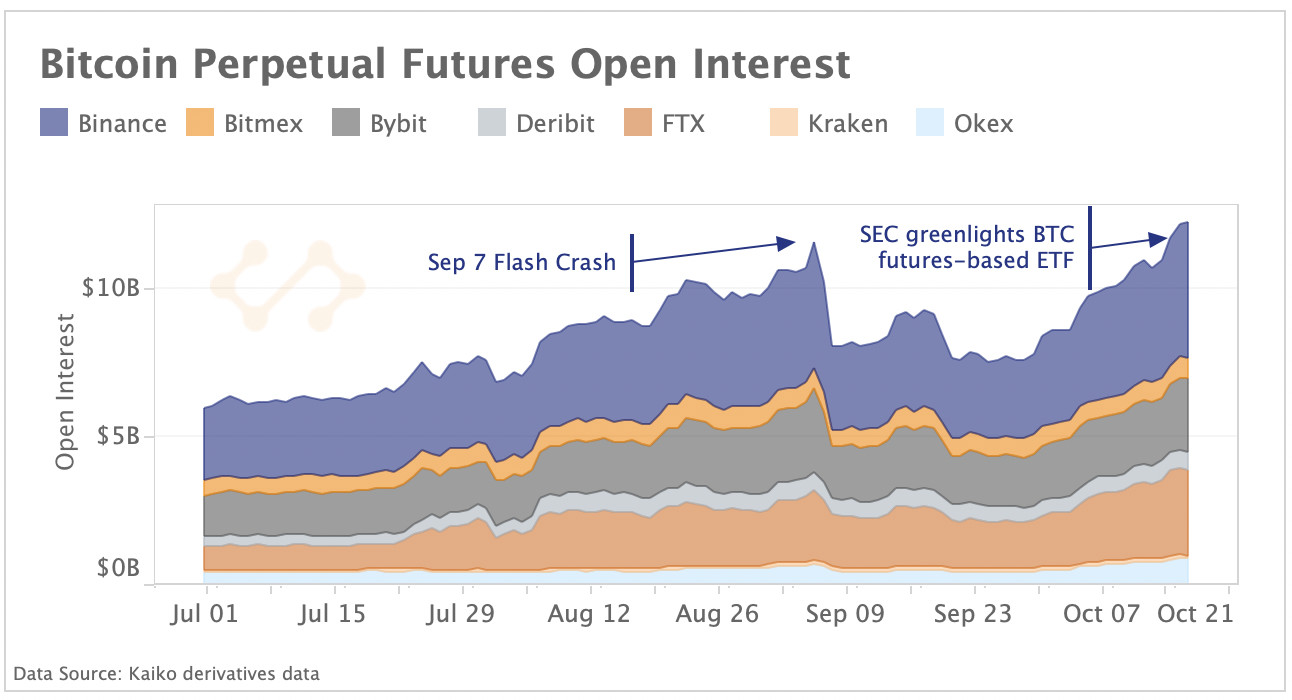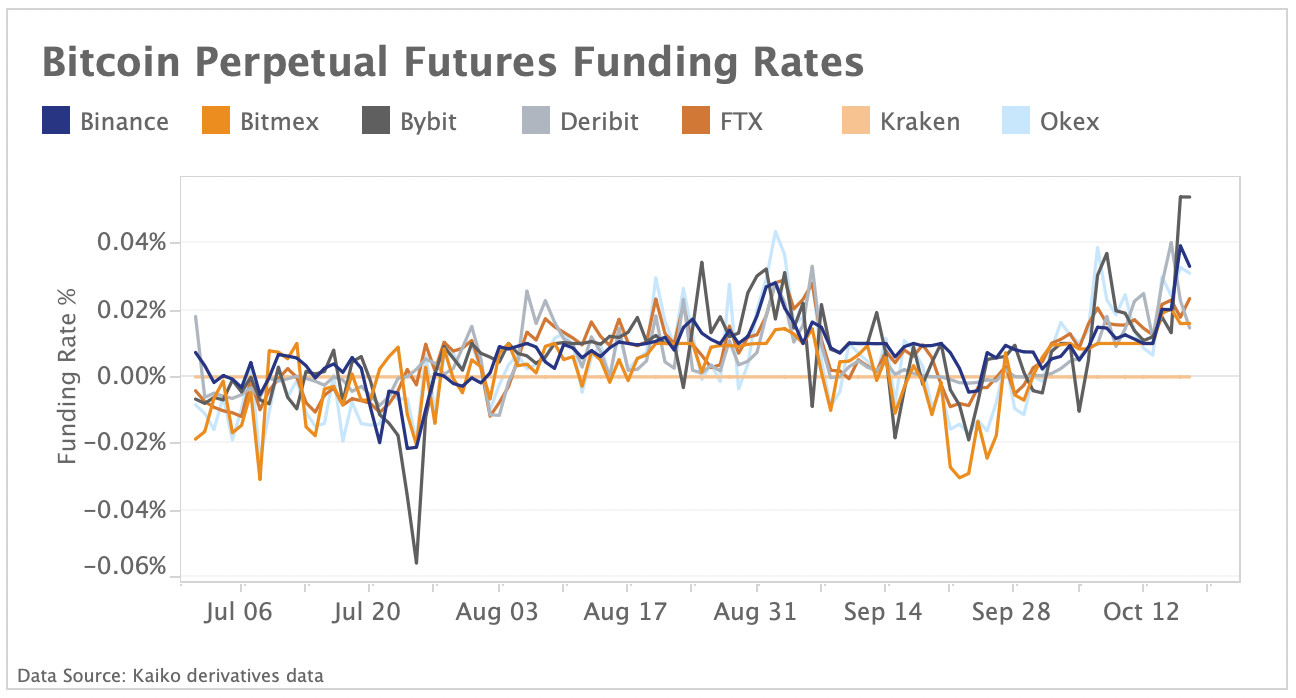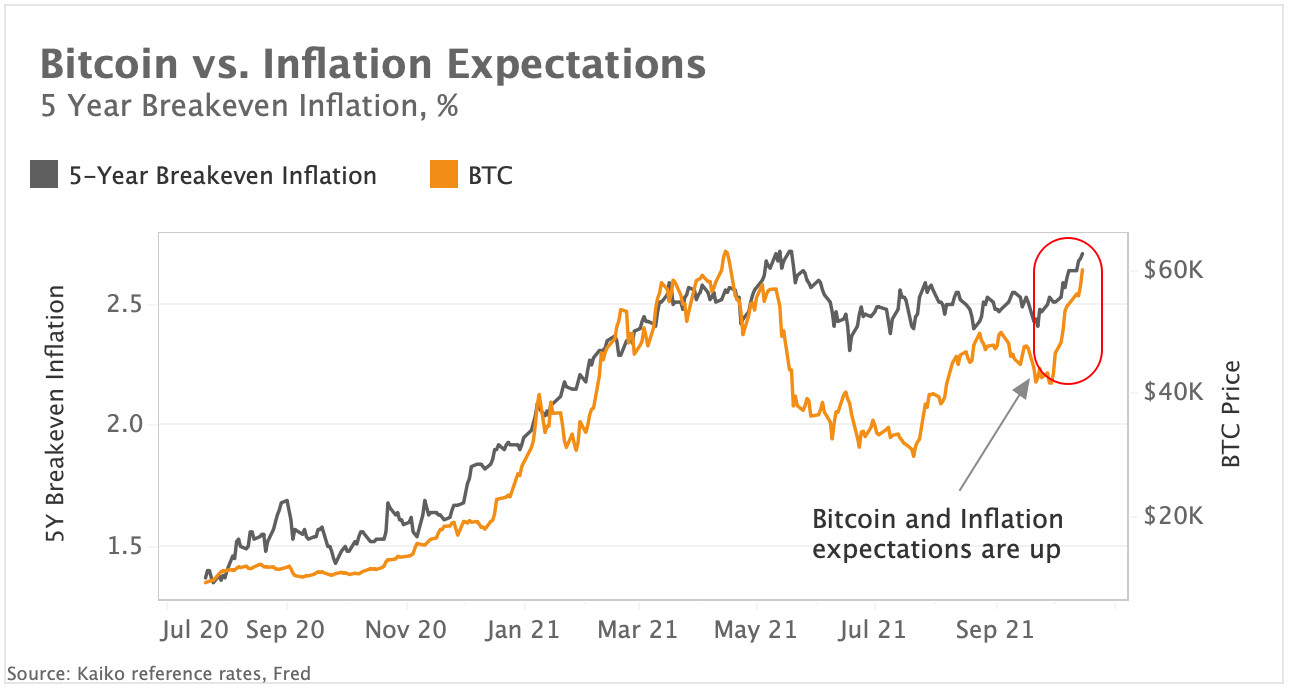A summarizing review of what has been happening at the crypto markets of the past week. A look at trending sectors, liquidity, volatility, spreads and more. The weekly report in cooperation with market data provider Kaiko.
The last 7 days in cryptocurrency markets:
- Price Movements: Bitcoin is approaching new all time highs following the SEC's approval of the first Bitcoin ETF.
- Volume Dynamics: Using trade data, we explore the source of the latest Bitcoin rally.
- Order Book Liquidity: Spreads are highest on average during the overlap between U.S. and European trading hours.
- Derivatives: Open interest on CME broke record highs.
- Macro Trends: Inflation expectations are at multi-year highs.
Bitcoin approaches all-time highs following ETF approval
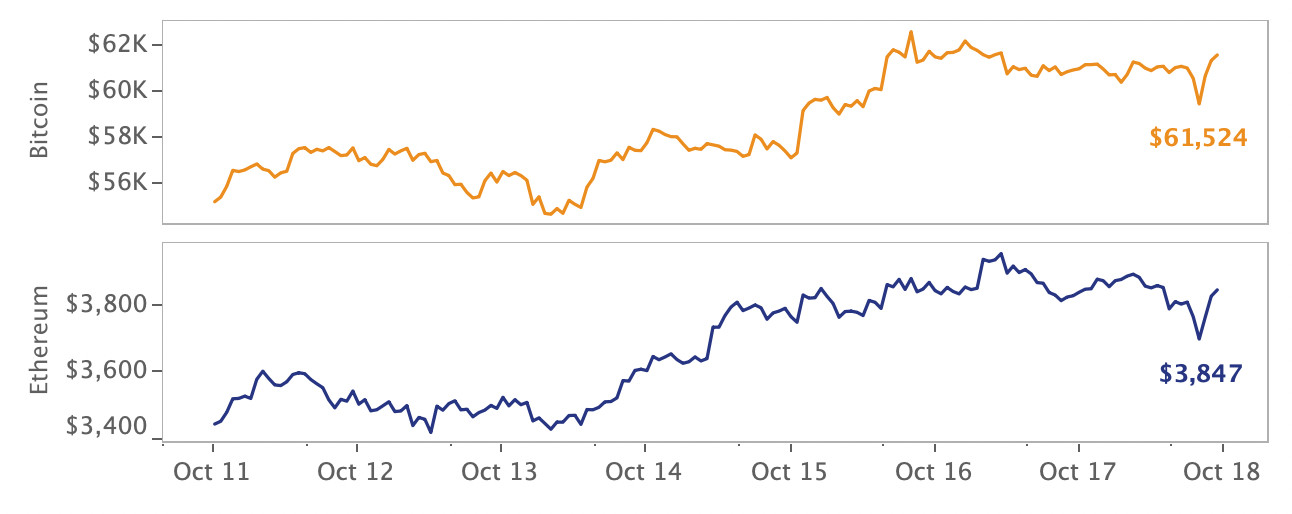
The Securities and Exchange Commission finally approved the first U.S. Bitcoin exchange-traded fund, a historic milestone for the cryptocurrency industry nearly eight years in the making. The approved ETF will track Bitcoin futures and be available to regulated institutions such as pension funds and asset managers in addition to regular investors trading on stock exchanges. The approval also opens the possibility of an eventual spot-based ETF, which has historically seen the largest number of applications and investor demand.
In other crypto news, exchanges are getting serious about regulatory compliance, Binance launched a $1B blockchain ecosystem fund, and Tether was fined $41 million by the CFTC. In traditional markets, higher-than-expected inflation data didn't negatively impact equities and treasury yields continued to rise.
Ethereum volatility dips as market share drops
Altcoin Summer has turned into Bitcoin Fall as returns for the largest crypto asset began outpacing the rest of the market. Ethereum in particular has underperformed compared with Bitcoin as of late, although this trend reversed slightly over the past few days. Ethereum's 20-day volatility is now equal to that of Bitcoin's and reached its lowest level since early August. The lack of strong price action reflects current trader interest: the market share of Bitcoin volume vs. Ethereum on top fiat exchanges is at 66%, up from 44% just one month ago. This suggests traders have rotated funds out of ETH markets and back into BTC.
Tether trading volume relative to USD spikes to a yearly high
Analysts love to speculate the source of strong price movements, however this is a notoriously difficult task considering price discovery is a complex process involving both spot and derivatives markets across dozens of exchanges. However, Bitcoin's latest rally which took off around October 10th shows clear signs of (at least partially) originating on Binance's BTC-USDT spot pair.
Trading volumes on Tether markets relative to USD markets displayed strong volatility from October 5th-10th, with the share of BTC-USDT spot trading increasing 17% to a yearly high of 82% before retracing to 69%. This suggests high amounts of momentum trading on spot Tether markets after major crypto-to-crypto exchanges announced additional restrictions for China-based users in response to the latest crackdown. To better understand the underlying dynamics in USDT spot markets we chart the BTC-USDT market share by exchange.
We observe that trading volumes spiked on Binance’s Tether market on October 10th relative to all other exchanges, surging from 50% to 68% reaching its highest level since April. The average Bitcoin trade size on the exchange also rose to a multi-month high between October 8-13 (from $2K to $2.5K). The trend could indicate increased trading from large investors (whales). However, the average trade size is not always indicative of the extent of whale trading as traders tend to break larger orders into smaller chunks to avoid slippage.
We further analyzed the minute-by-minute breakdown in volumes and corresponding average price on Binance (charted above). We observe that Bitcoin price varied strongly on October 10, after large amounts of trades were executed. It went up from $54K to $56K in just three hours between 2AM and 5AM UTC time (Asian opening hours) as buying orders exceeded sell orders over this period. The price also spiked between 19h30 and 20h30 UTC time (U.S. opening hours) from $55K to $56.4K before pulling back to $54.5K almost immediately as buying pressures decreased. The overall amount of buy orders slightly exceeded sell orders on October 9-10.
Since then, Bitcoin's price has steadily surged above $60k. We like to add a caveat that correlation in price/volume is not equal to causation, but the data this time does seem to point to the source of the latest rally.
Open interest and funding rates continue to climb
Open interest for Bitcoin perpetual futures rose to multi-month highs following the SEC's approval of the first U.S. Bitcoin ETF. Above, we chart the open interest on seven of the leading derivatives exchanges. We observe that bitcoin perpetual futures open interest increased by 50% in October to $12bn and is now higher than September's spike that immediately preceded the flash crash. FTX and Binance registered the strongest growth of 71% and 48% respectively.
Open interest on CME also surged to record highs last Friday. CME is the largest regulated derivatives platform catering to institutional traders. In the week preceding the ETF approval, the CME basis - the difference between the spot price and futures price - flipped that of retail derivatives exchanges for the first time, interpreted as a bullish sign for crypto markets.
Bitcoin funding rates, which are seen as a gauge of market sentiment, also continued rising last week, exceeding their levels from early September on most exchanges.
The funding rate or the cost of holding a long position was the highest on Bybit, Binance and Okex and the lowest on FTX and Deribit. The robust rise in open interest, volumes and funding rates suggests crypto markets remain on a clear upward trend despite the challenging macro environment.
Inflation expectations hit multi-year high
Market inflation expectations for the next five years hit their highest levels since 2005 last week (2.71%), boosted by surging energy costs and a hotter than expected September consumer-price reading. Central banks keep a close eye on inflation expectations as they can influence actual inflation rates in the future. If consumers and investors believe that inflation will rise further, they demand higher risk premiums and wages, additionally feeding inflation pressures. Above, we chart inflation expectations along with the price of Bitcoin. We observe they have been moving in lockstep over the past weeks, with Bitcoin surging from $42K mid-September to over $60K in early October.
The official line of the U.S. Fed and the European Central Bank is that the current inflationary pressures are transitory and are due to distortions related to Covid-19. However, the latest inflation report shows that U.S. inflation remained persistently high in September (up 5.4% y/y), despite fading base effects from last year’s lockdowns. This has fueled fears of stagflation - a period of sluggish growth and high inflation, rattling traditional financial markets in October.
Ethereum and Bitcoin offer the highest compensation for risk
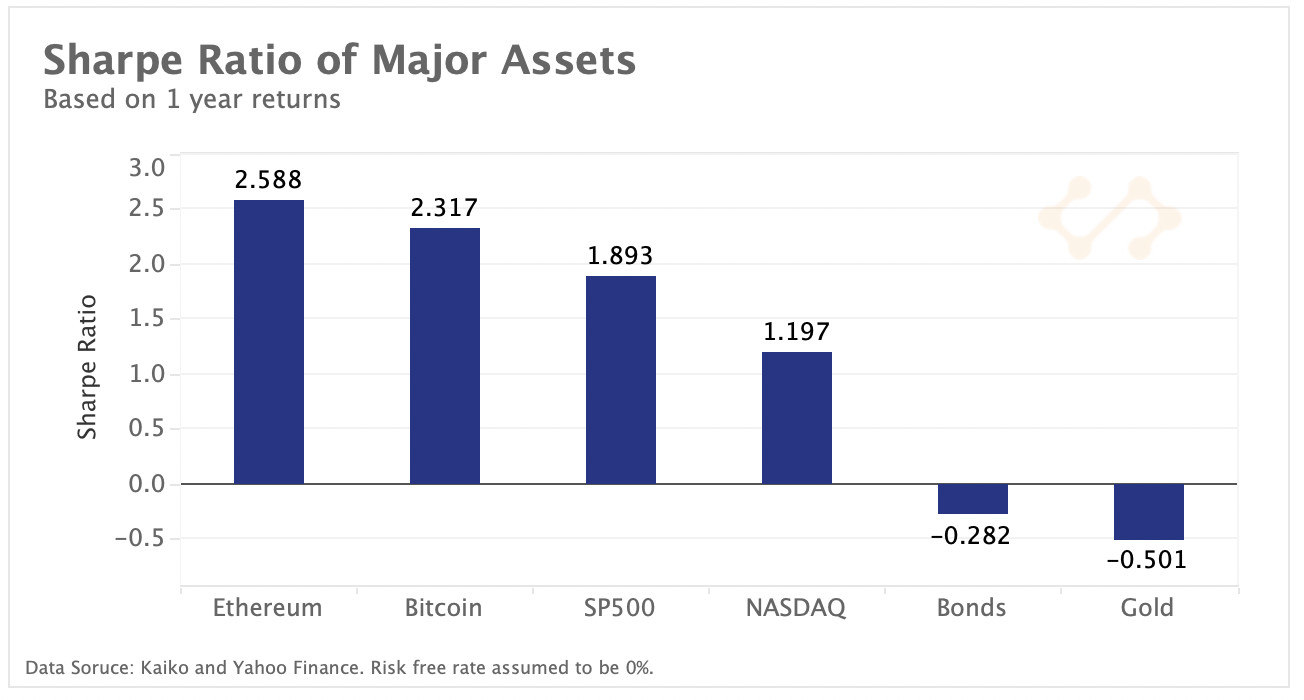 Crypto assets are generally more volatile than other asset classes such as equities. To analyse if the massive returns of crypto assets compensate investors despite elevated volatility, we need to consider risk adjusted returns. The sharpe ratio is one of the best-known reward to risk measures and is used to help investors understand the return of an investment compared to its risk. The higher the Sharpe ratio, the better an asset or portfolio’s risk-adjusted returns. For example, a Sharpe ratio of 2 indicates that the asset provides 2% return for each unit of volatility. Above, we chart the Sharpe ratio of major assets such as Bitcoin, Ethereum, S&P500, NASDAQ, U.S. bonds and Gold using the previous year of data. We observe that Ethereum and Bitcoin top the reward-to-risk chart while risk-off assets such as bonds or gold have underperformed. The superior risk adjusted returns of crypto assets over equities could potentially strengthen the use case of including cryptos in investment portfolios.
Crypto assets are generally more volatile than other asset classes such as equities. To analyse if the massive returns of crypto assets compensate investors despite elevated volatility, we need to consider risk adjusted returns. The sharpe ratio is one of the best-known reward to risk measures and is used to help investors understand the return of an investment compared to its risk. The higher the Sharpe ratio, the better an asset or portfolio’s risk-adjusted returns. For example, a Sharpe ratio of 2 indicates that the asset provides 2% return for each unit of volatility. Above, we chart the Sharpe ratio of major assets such as Bitcoin, Ethereum, S&P500, NASDAQ, U.S. bonds and Gold using the previous year of data. We observe that Ethereum and Bitcoin top the reward-to-risk chart while risk-off assets such as bonds or gold have underperformed. The superior risk adjusted returns of crypto assets over equities could potentially strengthen the use case of including cryptos in investment portfolios.


